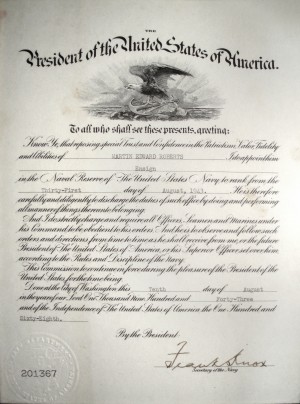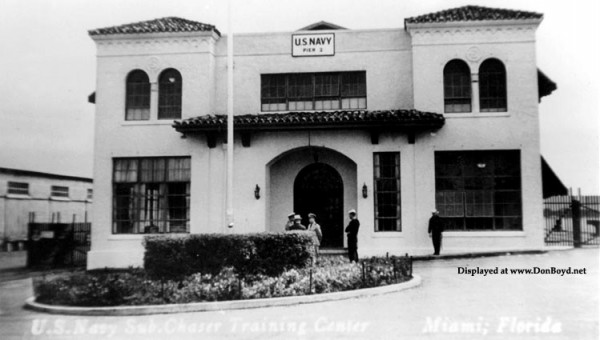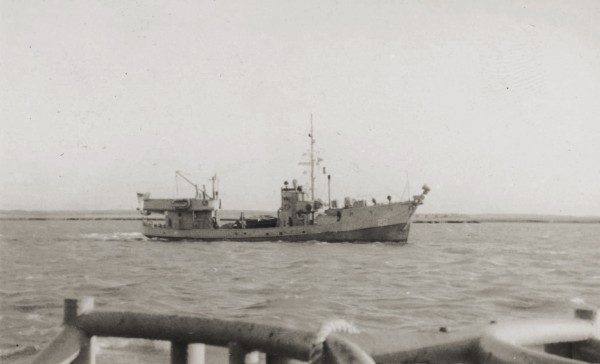Some months ago, I was contacted by a sailor who served aboard a sibling minesweeper across the American, European, and Pacific theatres of WWII. Lieutenant Marty Roberts of Raleigh, NC served aboard YMS-468 as Engineering Officer and later Deck Officer, from 1943 to 1946. Marty wrote up this biography of his naval service for his grandson and was kind enough to share it and his photographs with us.
This post is an eight-part series. Below is an index of all parts. Enjoy!
Marty Roberts of Raleigh, NC | February 28th, 2014
Navy Days – A Letter to Joe
- Part 1: In training
- Part 2: YMS-468 on the US East Coast
- Part 3: YMS-468 through Panama Canal, in prep for battle
- Part 4: YMS-468 on the US West Coast, into the Pacific Theatre
- Part 5: YMS-468 in battle, up to Japan’s surrender
- Part 6: YMS-468 in Makurazaki Typhoon
- Part 7: YMS-468 moored in Japan’s occupation
- Part 8: After the war
Part 1 of 8: In training
Hi Joe,
Knowing your interest in things naval, I have been collecting some more information about my experience in WWII and particularly about the task of clearing mines laid both by the Germans off our Atlantic coast and by the Japanese off Okinawa and around their islands.
Not so often referred to is the first naval engagement the US got into after entering the war. Hitler quickly decided to attack our shipping coming out of Delaware Bay from Philadelphia and Chesapeake Bay from Baltimore. This was done by his U-boats using both torpedoes and by laying mines in the entrances to these bays. One of his subs actually succeeded in getting into Chesapeake Bay and laid some mines there much to the embarrassment of our navy since this was also their largest base on the East Coast! Their attention was naturally focused on Pacific operations due to the Japanese attack at Pearl Harbor.
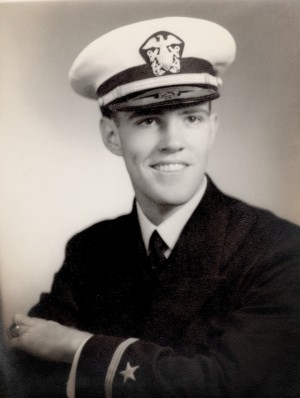
Ensign Marty E Roberts, 1943
Antisubmarine warfare (ASW) and minesweeping operations were soon set in motion both with ships and from the air. This started in 1942 and carried on into 1944 and I believe about 200 ships were sunk carrying vital cargo destined for the UK. During this time the YMS was designed and put into service as both ASW and minesweepers. The earlier YMS’s actually accompanied merchant ships halfway across the North Atlantic where your boys took over and completed the escort mission. We were equipped with sonar gear for detecting and tracking subs and with depth charges, “hedgehogs”, and one 3”/50 caliber gun for attacking them plus a pair of 20 mm guns. This supplemented all our minesweeping gear. Interestingly, we built a couple dozen YMS’s for the UK and they were known as BYMS’s.
After I received my commission in August 1943 my first assignment was to report to SCTC (Submarine Chaser Training Center) in Miami, FL. Here we learned how to use the sonar equipment to detect submarines and plot their positions and how to time the depth charges and launch the hedgehogs to shake up the enemy subs. The former were set to go off at a certain depth and then rolled off racks mounted on the port and starboard corners of the ship’s stern. The latter were smaller charges that were fired into the air by explosive launchers mounted on each side of the ship, resulting in a rather wide pattern of trouble for the sub.
After SCTC I was sent to the US Naval Base at Cape May, NJ which is very near the entrance to Delaware Bay for training in the use of minesweeping equipment to clear contact, magnetic, and acoustically detonated mines. The practical part of this was to sweep a marked channel approaching the bay entrance using all the different types of sweep gear. The ships (if you could call them that) were converted fishing boats designated as AMc’s that had names of birds, like the Canary, etc. There was no room for a proper electric generator so the power for the magnetic sweep gear actually came from dozens of wet cell batteries! Going into the generator compartment meant exposure to a fine spray of battery acid that soon dissolved holes in one’s uniform! We spent the winter of 1943/1944 sweeping that channel and learning how to use all the equipment.
The best thing about this assignment was that I met a young high school science teacher from a little nearby town called Cape May Court House and (guess what) she became your grandmother, Muriel Roberts!
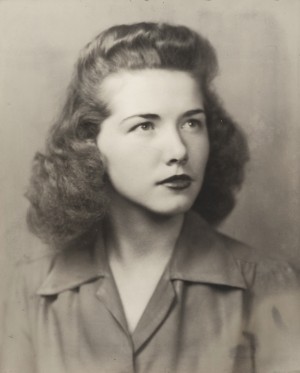
Muriel
This post is an eight-part series. Below is an index of all parts. Enjoy!
Marty Roberts of Raleigh, NC | February 28th, 2014
Navy Days – A Letter to Joe
- Part 1: In training
- Part 2: YMS-468 on the US East Coast
- Part 3: YMS-468 through Panama Canal, in prep for battle
- Part 4: YMS-468 on the US West Coast, into the Pacific Theatre
- Part 5: YMS-468 in battle, up to Japan’s surrender
- Part 6: YMS-468 in Makurazaki Typhoon
- Part 7: YMS-468 moored in Japan’s occupation
- Part 8: After the war
